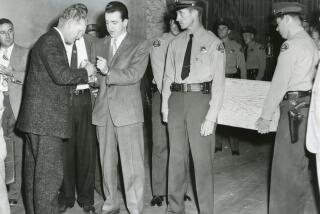The Issue in the Horror of Milwaukee
- Share via
No doubt conscientious probation officers here and across the nation cringed as the gruesome story of one Milwaukee ex-con unfolded before the nation’s eyes. And therein lies a tale that’s been told over and over again but bears repeating.
When police entered the foul-smelling apartment of Jeffrey L. Dahmer--a 31-year-old convicted child molester--they discovered the dismembered body parts of at least 11 men. They also found another demonstration of why politicians are able to make hay out of bungled parole, probation and furlough programs.
Dahmer had been on probation after serving 10 months on a 1988 conviction for sexual assault against a teen-age boy. In jail, he wrote a letter to a judge oozing with remorse and pleading for early release. “What I did was deplorable,” he wrote. “The world has enough misery without my adding more to it. Sir, I can assure you it will never happen again.” Four months later Dahmer was released and consigned to the supervision of state probation agents.
Precisely when the parolee began his spree of serial murder and dismemberment is not known. Certainly the police, who Friday suspended three officers for possibly bungling one of the murder cases linked to Dahmer, and probation authorities in Milwaukee are in no position to help clear up the mystery. Though agents are required to visit probationers’ homes, this was waived in Dahmer’s case. The reason, explain authorities, is that the agent in question was swamped with work and Dahmer lived in a high-crime area that the agent feared to visit.
No doubt that official explanation causes deep distress among serious advocates of probation. They know the system is so understaffed and under-funded that officials have to make such unpalatable priority decisions, and that sometimes they get them wrong. Probation officers in Milwaukee are as overworked as their counterparts everywhere; and no doubt fewer probationers live in Milwaukee’s best ZIP codes than in its worst. But the way Dahmer was allowed to slip through the cracks of the probation system is a scandal.
It’s true--as this newspaper has editorialized--that the use of Willie Horton by GOP strategists in 1988 was unfortunate because it fanned racial fears. But it was doubly unfortunate because it obscured a real issue. Horton, who happened to be a black man, raped a woman while on weekend furlough from a Massachusetts prison. The legitimate issue was not his race but his criminality--and whether our system of early criminal release is up to the task assigned to it. It wasn’t in Horton’s case. It wasn’t in Dahmer’s case. That’s the issue.
More to Read
Sign up for Essential California
The most important California stories and recommendations in your inbox every morning.
You may occasionally receive promotional content from the Los Angeles Times.










